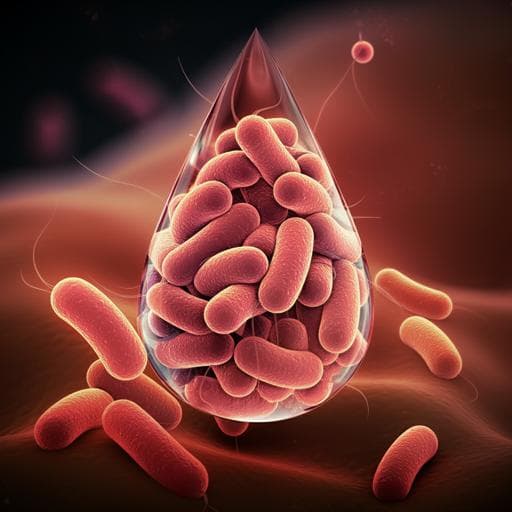
Environmental Studies and Forestry
Integrating water-quality analysis in national household surveys: water and sanitation sector learnings of Ecuador
L. Moreno, M. Pozo, et al.
Explore the critical findings from an in-depth analysis of water quality in Ecuador, revealing that water quality is a significant barrier to safe drinking water access. This essential research by Lorena Moreno, Mónica Pozo, Koenraad Vancraeynest, Robert Bain, Juan Carlos Palacios, and Fausto Jácome calls for urgent improvements in water quality control and surveillance.
~3 min • Beginner • English
Introduction
At the conclusion of the MDG era in 2015, worldwide, 2.4 billion people still did not use improved sanitation supplies, and 663 million did not have access to improved sources of drinking water. Water and sanitation related diseases remain a leading cause of death for children under 5. Evidence indicates water contamination is more common at the point of consumption than at the source, suggesting deterioration during collection and household handling. Globally, 117 countries have estimates on safely managed drinking water services, covering 38% of the population; 5.3 billion people use safely managed services, while significant proportions still use basic, limited, unimproved, or surface water sources. Ecuador, with 17 million people across four diverse regions (coast, highlands, Amazon, insular), has fragmented drinking water and sanitation service provision across 221 municipalities and thousands of rural community providers, necessitating strong monitoring and regulation to assure compliance with national standards (INEN 1108). Despite existing standards and requirements for monitoring (e.g., fecal coliforms), Ecuador has lacked a clear framework for water-quality control and surveillance. Since 2016, INEC strengthened household surveys to enable SDG 6.1/6.2 monitoring, including E. coli testing at household source (2016) and both source and point of consumption (2019). This study presents extended analyses from these surveys to examine temporal changes in water quality, determinants of access to safely managed drinking water, contamination from service provision to consumption, and factors associated with point-of-consumption quality. The objective is to inform national sector analysis and decision-making towards SDG 6.1, and contribute to global monitoring discussions.
Literature Review
Methodology
Data sources included national household surveys (ENEMDU December 2016 and March 2019), administrative records (Census of municipalities 2016/2017; ARCA community provider reports 2017 in SARA), INEC population projections, and meteorological data. ENEMDU is a probabilistic survey primarily measuring labor market indicators; in 2016, 26 new WASH questions (14 water, 6 sanitation, 6 hygiene) were added, drawing from MICS and DHS, with sector agency input. Water-quality testing used Colitag to assess presence/absence of E. coli in 100 ml, with incubation 24–48 h. Due to cost/logistics, testing was on subsamples: 4,442 households in Dec 2016 (source only), and 7,331 households in Mar 2019 (source and point of consumption), enabling national, urban, and rural disaggregation. 2016 ENEMDU total sample: 31,092 households; 2019: 16,954 households. National SDG 6.1.1 was adapted: Ecuador excludes rainwater as improved (storage unverified), defines availability as sufficient drinking water in last 2 weeks, and uses absence of E. coli as proxy for “free from contamination” (no chemical testing). Statistical analysis: - Temporal comparison of source-level water quality (2016 vs 2019) using hypothesis tests to assess significance of changes in components of safely managed services (source type, quality, accessibility/on-premises, availability). - Structural 2019 analysis included kernel regression of safely managed access vs income, and Shapley value decomposition to quantify average marginal contribution of each component (across 24 combinations) to the composite indicator. - Linking administrative records with survey data: Administrative data from AME and ARCA on INEN 1108 compliance and treatment were geospatially paired to ENEMDU to estimate the probability a household on piped supply receives water meeting the standard. This enabled tracing quality along stages: provider compliance, household source quality, household treatment, and point-of-consumption quality (Sankey analysis). - Associated factors for point-of-consumption water quality: Logistic regression models with Huber-White robust standard errors at the person level (N≈25,924) estimated marginal effects of immediate factors (source quality, household treatment, hygiene: handwashing facilities/soap; sanitation: limited/not improved/open defecation), extended factors (provider compliance, source type, accessibility), and social factors (rural/urban, region, income per capita, ethnicity, household composition, education of household head). Conditional models assessed treatment effects stratified by source quality (contaminated vs non-contaminated). Meteorological data (e.g., precipitation from INOCAR and national sources) contextualized timing differences between Dec 2016 (dry season end) and Mar 2019 (peak rainy season).
Key Findings
- Safely managed drinking water services: Nationally 70.1% (2016) vs 67.8% (2019), a nonsignificant decrease; urban 79.1% vs 76.9%; rural 51.4% vs 48.5%. The urban–rural gap remained ~28 percentage points. - Source-level water quality declined significantly between 2016 and 2019: −5.9 percentage points (p=0.0002) nationally; rural −9.5 pp (p=0.0004); urban −4.3 pp (p=0.0263). The coastal region drove much of the decline. Availability improved significantly nationally (p=0.0001), in rural (p=0.0002), urban (p=0.0471), and highlands (p=0.0001). - Seasonality context: Precipitation in Mar 2019 (rainy season peak) was ~6× higher than Dec 2016 (end of dry season), particularly in Guayaquil/coastal areas, potentially influencing water quality outcomes. - Determinants of safely managed access: Venn and component analyses show water quality is the principal limiting factor, followed by source type; accessibility and availability contribute marginally to the gap. If E. coli contamination were eliminated nationwide with other factors unchanged, safely managed access would increase by 20.6 percentage points to 88.4%. - Tracing contamination (2019): 52.2% of population connected to piped supply compliant with INEN 1108; 14.8% to piped noncompliant; 33.0% rely on other sources (24.5% improved non-piped; 6.5% unimproved; 2.0% surface). At household source level, 73.5% had E. coli-free water (52.0% piped and clean). Among improved non-piped, 73.1% were clean; unimproved 43.6% clean; surface sources 32.6% clean. - Household treatment and quality changes: 26.6% had E. coli at source; 37.8% of them reported treatment. Among those with contaminated source who boiled, 28.1% achieved clean water at consumption (71.9% remained contaminated); other treatments: 28.9% improved, 71.1% remained contaminated. Notably, 13.3% of households with clean source water had contamination at the point of consumption despite reporting treatment; without treatment, 11.7% became contaminated, indicating handling/storage issues. - Immediate factors (marginal effects on probability of clean water at consumption): Source quality has a large positive effect (ME≈+0.773, SE=0.004). Open defecation (−0.119***), unimproved sanitation (−0.0466***), lack of water/soap (−0.0119, ns), and no facility (+0.0177**) showed expected directions. - Conditional treatment effects: When source was contaminated, boiling (+0.235***) and other treatments (+0.275***) significantly increased the probability of clean consumption water; when source was clean, boiling had a small negative effect (−0.027***), suggesting possible recontamination or reporting bias. - Extended factors: Provider compliance (% water under local norm) positively associated (+0.0837***). Source type B (−0.185***) and C (−0.130***) and longer collection time (<30 min vs on premises: −0.136***) reduced the probability of clean water at consumption. Open defecation strongly negative (−0.159***). - Social factors: Rural residence (−0.183***); regions Coast (−0.149***), Amazon (−0.257***), Insular (ns). Ethnicity: Afro-Ecuadorian (−0.0429**), Montubio (−0.0494***), Mestizo (−0.0098 ns), White/other (ns). Higher income (+0.0373*** per ln unit) and higher education of household head (secondary +0.0564***; tertiary +0.118***) increased probability of clean water at consumption. - WASH ladders (Table 1): Notable 2016–2019 changes include increases in BASIC 2 water (18.3%→21.5%**), sanitation basic (44.2%→48.5%**), reductions in limited sanitation (10.4%→6.1%*) and unimproved sanitation (1.8%→1.0%*), and improved hygiene basic (85.5%→89.1%**); no service in hygiene rose (1.9%→3.3%**).
Discussion
Integrating E. coli testing into Ecuador’s national household surveys enabled robust SDG 6.1 monitoring and deeper sector insights. The two rounds (2016 source-only; 2019 source and consumption) reveal that water quality is the dominant barrier to safely managed access, and that quality can deteriorate between the household source and point of consumption due to handling, storage, and hygiene practices. The observed national decline in source-level quality from 2016 to 2019 coincided with markedly higher precipitation in 2019, highlighting potential seasonal effects; thus, declines cannot be attributed solely to service performance without considering seasonality. Linking administrative compliance data (INEN 1108) with survey measurements showed close correspondence between provider-reported compliant piped supplies and measured E. coli-free piped water at the household source, suggesting administrative records can partially substitute source-level testing for SDG 6.1 estimates, though they do not capture point-of-consumption risks. Regression analyses underscore the primacy of source quality and the critical roles of sanitation and hygiene: open defecation and unimproved sanitation are strongly associated with contamination at consumption; household treatment (especially boiling) improves outcomes when source water is contaminated but may not help—and can be negative—when source water is already clean, likely due to recontamination or inconsistent practices. Social disparities persist: rural and certain regions (especially Amazon) face higher risks; higher income and education mitigate risks. These findings inform policy: prioritize risk-based water quality control and surveillance; target hygiene behavior change (handwashing with soap, safe storage) and sanitation improvements; consider seasonal dynamics in monitoring and operational strategies; and maintain point-of-consumption testing to capture actual exposure risks.
Conclusion
Aligning national monitoring with SDG 6.1 and incorporating water-quality testing into household surveys produced actionable evidence for Ecuador’s water sector. The study shows: (1) water quality is the principal bottleneck preventing progression to safely managed services; resolving contamination alone could raise safely managed coverage by ~20.6 percentage points; (2) contamination can occur between provider delivery and consumption, underscoring the need to complement source-focused interventions with household hygiene and safe storage; (3) administrative records of provider compliance align reasonably with source-level survey results and can support monitoring, but cannot replace point-of-consumption testing. Policy priorities include establishing a risk-based water quality control and surveillance framework (e.g., residual chlorine monitoring), strengthening regulation across a fragmented provider landscape, and integrating hygiene and sanitation behavior change with household water treatment promotion—particularly where sources are contaminated. Future work should: (a) refine survey timing to account for seasonality; (b) expand testing beyond E. coli to include priority chemical contaminants; (c) measure and promote safe storage practices; and (d) investigate causes of limited net impact of household water treatment to optimize interventions.
Limitations
- Timing/seasonality: 2016 sampling (December, end of dry season) vs 2019 (March, peak rainy season) limits comparability; observed declines in quality may reflect seasonal effects rather than service deterioration. - Testing scope: Only E. coli was measured; no chemical contaminants were assessed, limiting the completeness of “free from contamination.” - Survey representation: 2019 water-quality subsample enables national, urban, and rural estimates but not municipal-level representativeness, constraining local performance assessment. - Cost/logistics: National-scale, dual-sample (source and consumption) testing is resource-intensive, limiting ability to test across multiple seasons. - Administrative records: Provider compliance data are self-reported annually and may emphasize bacteriological control; they do not conclusively confirm full compliance with all INEN 1108 parameters. - Behavioral data gaps: Surveys did not capture safe storage practices; self-reported household treatment may be inconsistent, affecting interpretation of treatment effectiveness. - Trend analysis: Authors note lack of strict comparability between 2016 and 2019 hampers establishing definitive trends.
Related Publications
Explore these studies to deepen your understanding of the subject.







